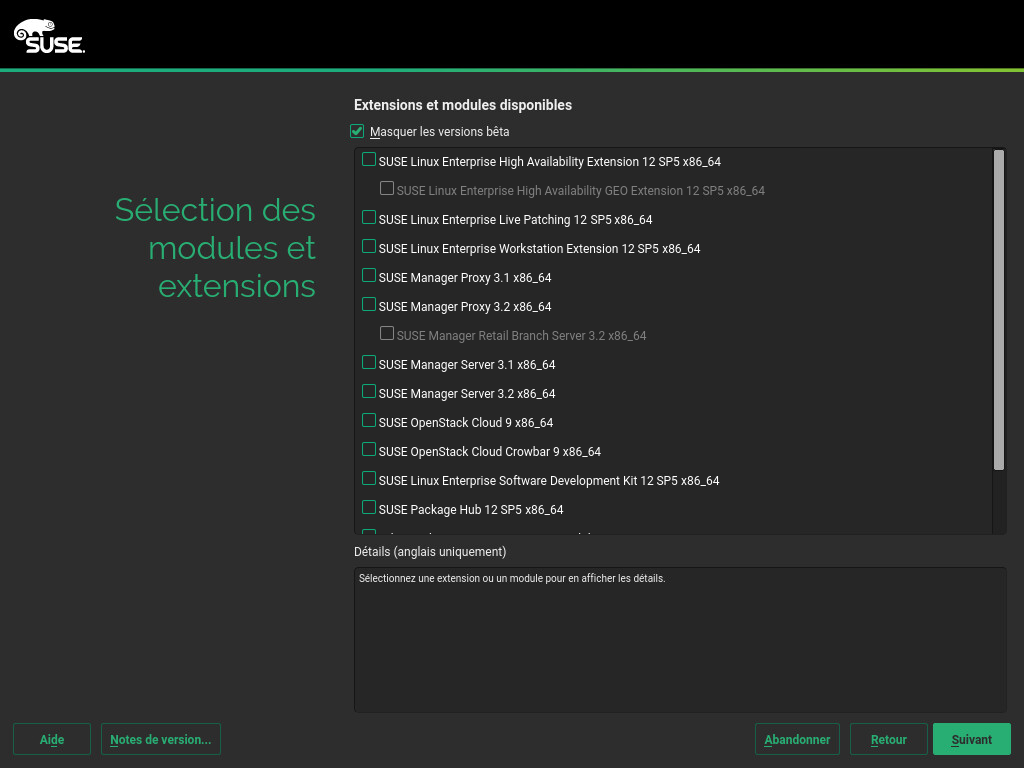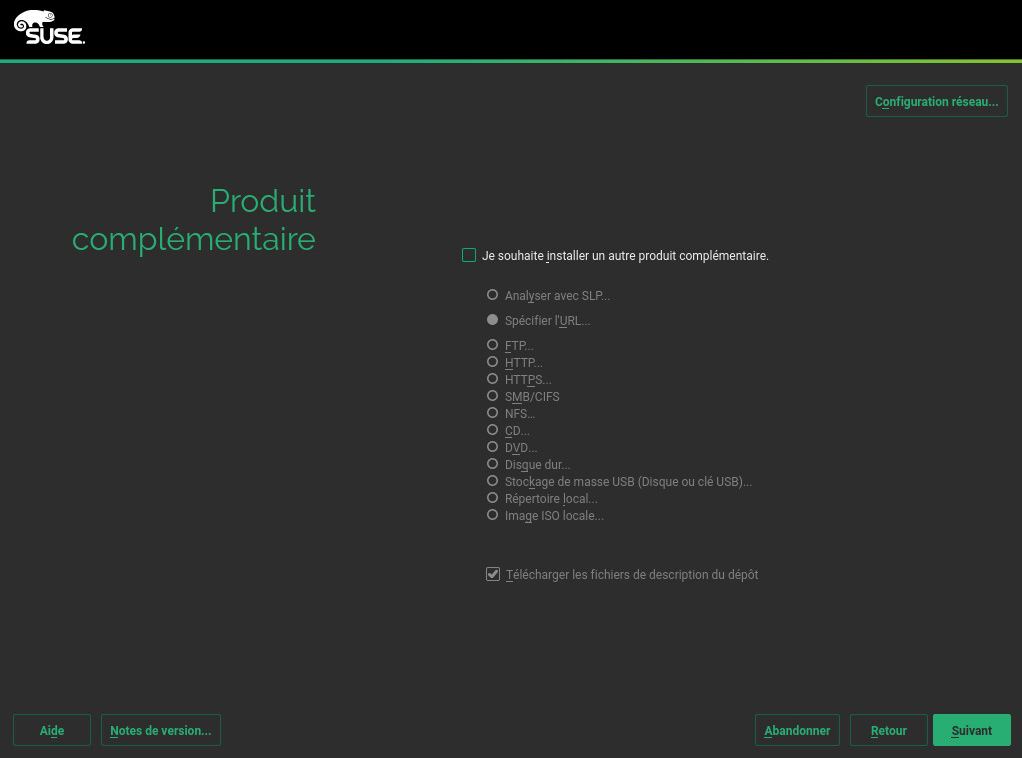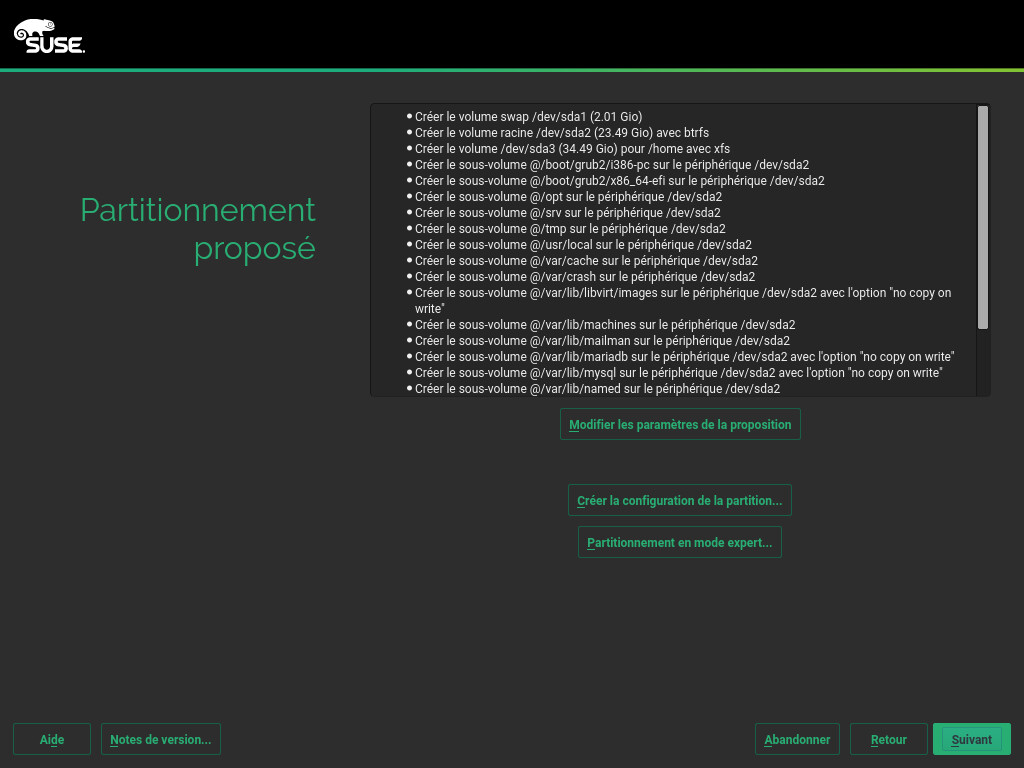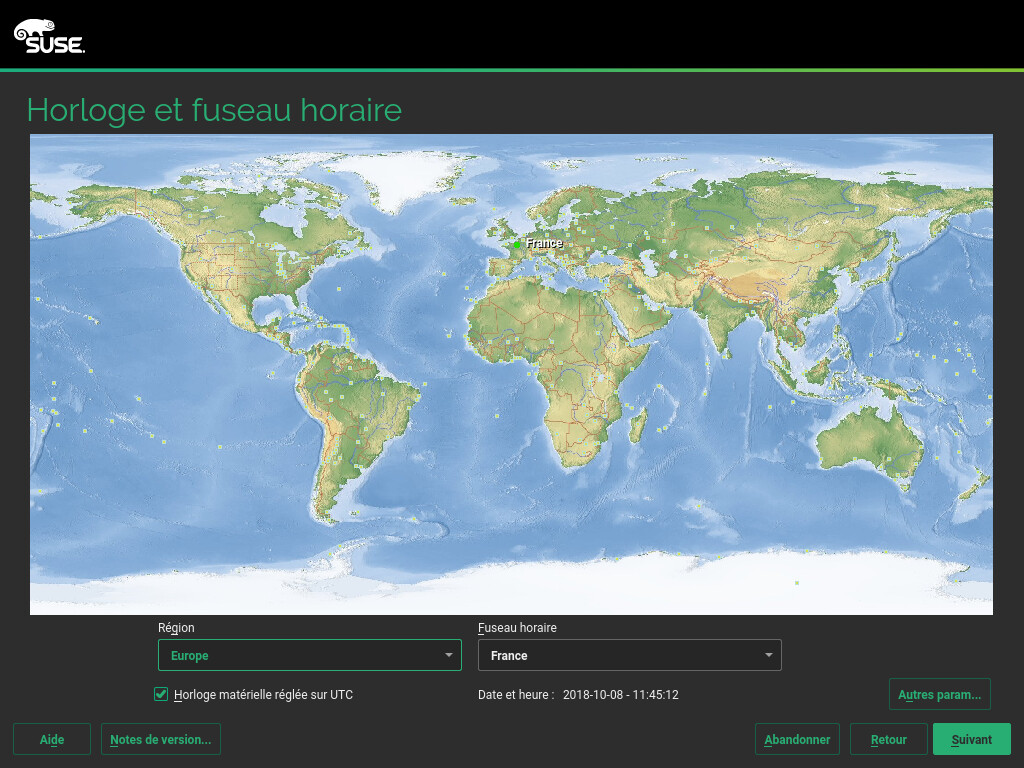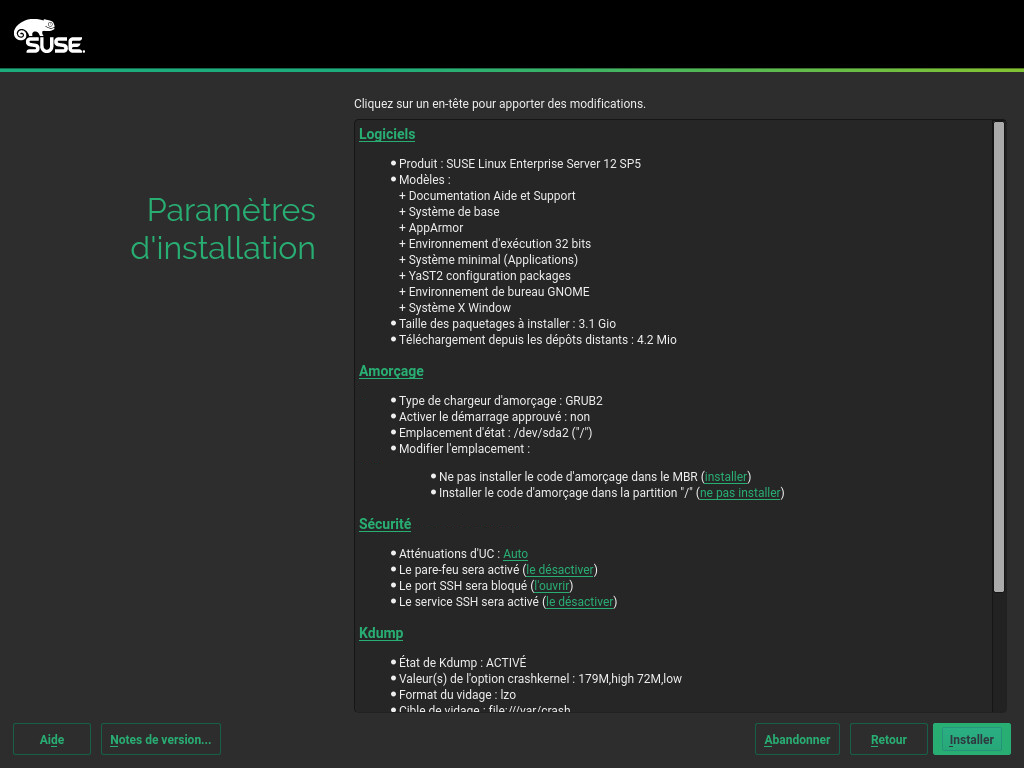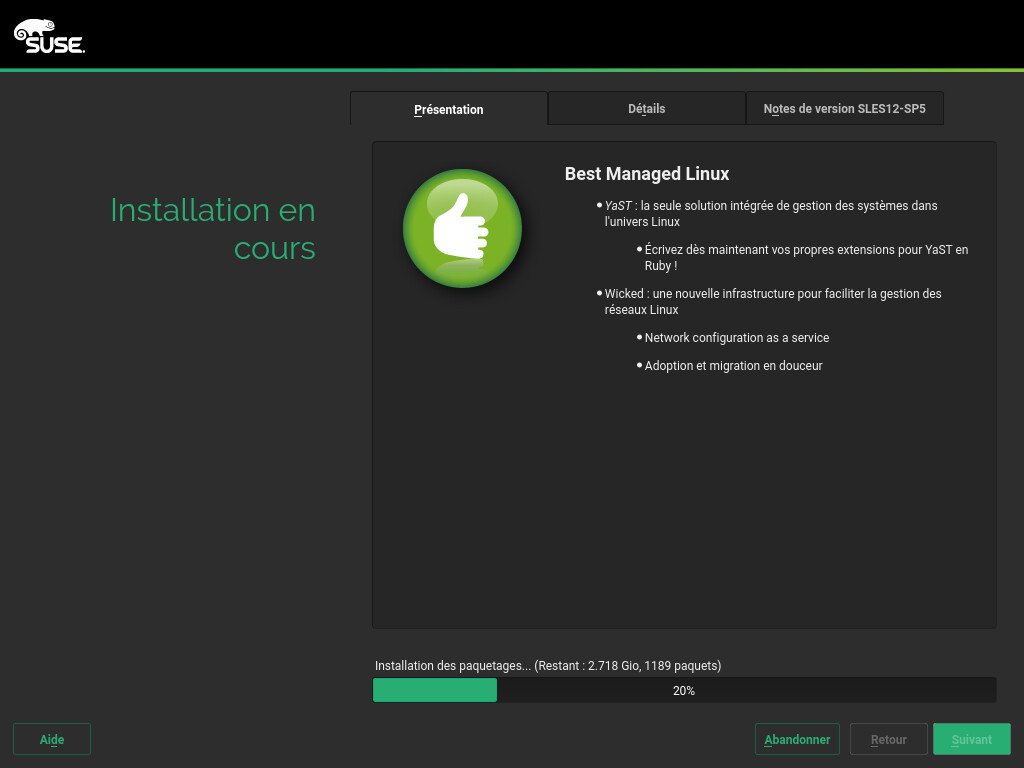Démarrage rapide de l'installation #
SUSE Linux Enterprise Server 12 SP5
Répertorie les configurations système requises et indique comment installer SUSE Linux Enterprise Server depuis un DVD ou une image ISO.
Utilisez les procédures suivantes pour installer une nouvelle version de SUSE® Linux Enterprise Server 12 SP5. Ce document explique brièvement comment exécuter une installation par défaut de SUSE Linux Enterprise Server sur l'architecture AMD64/Intel 64.
1 Bienvenue dans SUSE Linux Enterprise Server #
Pour obtenir des instructions d'installation plus détaillées et connaître les stratégies de déploiement, reportez-vous à la documentation de SUSE Linux Enterprise Server à l'adresse suivante : https://documentation.suse.com/
1.1 Configuration système minimale requise #
Processeur AMD64/Intel* EM64T (les processeurs 32 bits ne sont pas pris en charge)
512 Mo de mémoire RAM physique (1 Go ou plus recommandé)
3,5 Go d'espace disque disponible (plus recommandé)
Résolution d'affichage 800 x 600 (1024 x 768 ou plus recommandé)
1.2 Installation de SUSE Linux Enterprise Server #
Utilisez ces instructions en l'absence de système Linux existant sur votre machine ou si vous souhaitez remplacer un système Linux existant.
Insérez le DVD de SUSE Linux Enterprise Server dans le lecteur, puis redémarrez l'ordinateur pour lancer le programme d'installation. Les machines équipées d'un BIOS traditionnel affichent l'écran de démarrage graphique illustré ci-dessous. Les machines équipées de l'interface UEFI affichent un écran de démarrage légèrement différent. Le démarrage sécurisé sur les machines UEFI est pris en charge.
Utilisez la touche F2 pour changer la langue du programme d'installation. Une disposition du clavier correspondant est automatiquement choisie. Pour plus d'informations sur la modification des options de démarrage, consultez le Section 6.2.2.1, « Écran de démarrage sur les ordinateurs équipés d'un BIOS traditionnel » ou le Section 6.2.2.2, « Écran de démarrage sur les machines équipées de l'interface EUFI ».
Sélectionnez dans l'écran de démarrage, puis appuyez sur Entrée. Cette opération démarre le système et charge le programme d'installation de SUSE Linux Enterprise Server.
La et la sont initialisées en fonction du paramètre de langue choisi sur l'écran de démarrage. Changez-les ici, si nécessaire.
Lisez le contrat de licence. Celui-ci s'affiche dans la langue sélectionnée sur l'écran de démarrage. Des sont disponibles. Vous devez accepter l'accord de licence en cochant la case afin d'installer SUSE Linux Enterprise Server. Cliquez ensuite sur .
Une analyse système est effectuée, lors de laquelle le programme d'installation recherche des périphériques de stockage et d'autres systèmes installés. Si le réseau n'a pas pu être configuré automatiquement lors du lancement du système d'installation, la boîte de dialogue s'affiche.
Une fois qu'au moins une interface réseau a été configurée, vous pouvez enregistrer votre système auprès du service clientèle SUSE. Saisissez l'adresse électronique associée à votre compte avec le service clientèle SUSE ainsi que le code d'enregistrement pour SUSE Linux Enterprise Server. La réussite de l'enregistrement constitue une condition préalable à l'obtention des mises à jour produit et à l'accès au support technique. Cliquez ensuite sur .
Astuce : installation de correctifs produit lors de l'installation du système d'exploitationLorsque SUSE Linux Enterprise Server a bien été enregistré auprès du service clientèle SUSE, vous devez indiquer si vous souhaitez installer les dernières mises à jour disponibles en ligne au cours de l'installation. Si vous sélectionnez , le système sera installé avec les paquetages les plus récents sans avoir à appliquer les mises à jour une fois l'opération effectuée. L'activation de cette option est recommandée.
Remarque : notes de versionÀ partir de maintenant, les notes de version peuvent être consultées sur n'importe quel écran au cours du processus d'installation en sélectionnant .
Une fois qu'un système a bien été enregistré, YaST répertorie les modules et extensions disponibles pour SUSE Linux Enterprise Server à partir de SUSE Customer Center. La liste contient des modules gratuits, tels que le kit de développement logiciel (SDK) SUSE Linux Enterprise, ou des extensions qui nécessitent une clé d'enregistrement payante. Cliquez sur une entrée pour en afficher la description. Vous pouvez également sélectionner un module ou une extension à installer en cochant la case correspondante. Cliquez ensuite sur .
La boîte de dialogue vous permet d'ajouter des sources de logiciel supplémentaires (également appelées « dépôts ») à SUSE Linux Enterprise Server, qui ne sont pas fournies par le service clientèle SUSE. Ces produits complémentaires peuvent être un produit tiers, un pilote ou un logiciel supplémentaire pour votre système.
Astuce : ajout de pilotes au cours de l'installationVous pouvez également ajouter des dépôts de mises à jour de pilote au moyen de la boîte de dialogue . Les mises à jour des pilotes pour SUSE Linux Enterprise sont disponibles à l'adresse suivante : http://drivers.suse.com/. Ces pilotes ont été créés via le programme SolidDriver SUSE.
Si vous voulez ignorer cette étape, cliquez sur . Dans le cas contraire, cochez la case . Indiquez un type de média, un chemin local ou une ressource réseau hébergeant le dépôt et suivez les instructions affichées à l'écran.
Cochez pour télécharger directement les fichiers décrivant le dépôt. Si cette case n'est pas cochée, ils seront téléchargés une fois que l'installation aura commencé. Continuez en cliquant sur et insérez un support si nécessaire. Suivant le contenu du produit, vous devrez peut-être accepter des licences d'utilisation supplémentaires. Cliquez ensuite sur . Si vous avez choisi un produit complémentaire nécessitant une clé d'enregistrement, vous devrez la saisir sur la page .
Choisissez le qui répond le mieux à vos besoins. Sélectionnez pour les machines physiques ou les invités virtuels. Pour un hôte de virtualisation pouvant exécuter d'autres machines virtuelles, sélectionnez ou .
Passez en revue la configuration de la partition proposée par le système. Si besoin, modifiez-la. Vous avez les options suivantes :
Vous permet de modifier les options des paramètres proposés, mais pas la disposition de la partition suggérée elle-même.
Permet de sélectionner un disque auquel appliquer la proposition.
Ouvre la fenêtre de décrite dans le Section 12.1, « Utilisation de l'outil de partitionnement de YaST ».
Pour accepter la configuration proposée sans apporter de modifications, cliquez sur pour continuer.
Sélectionnez l'horloge et le fuseau horaire à utiliser sur votre système. Pour ajuster manuellement l'heure ou configurer un serveur NTP à des fins de synchronisation horaire, choisissez . Pour de plus amples informations, reportez-vous au Section 6.12, « Horloge et fuseau horaire ». Cliquez ensuite sur .
Pour créer un utilisateur local, saisissez votre prénom et votre nom dans le champ , votre nom de connexion dans le champ et votre mot de passe dans le champ .
Votre mot de passe doit contenir huit caractères au minimum sous la forme d'une combinaison de lettres majuscules et minuscules et de chiffres. Les mots de passe ne peuvent pas comporter plus de 72 caractères ; de plus, ils sont sensibles à la casse.
Pour des raisons de sécurité, il est également fortement recommandé de ne pas activer la fonction de . Vous ne devez pas non plus , mais plutôt fournir un mot de passe
rootdistinct lors de l'étape d'installation suivante. Cliquez ensuite sur .Saisissez le mot de passe du compte de l'administrateur système (l'utilisateur
root).N'oubliez pas votre mot de passe
root! Une fois que vous l'avez saisi, il vous est impossible de le récupérer. Pour plus d'informations, reportez-vous au Section 6.14, « Mot de passe de l'administrateur systèmeroot». Cliquez ensuite sur .Utilisez l'écran pour passer en revue et, si besoin, modifier certains des paramètres d'installation proposés. La configuration actuelle est répertoriée pour chaque paramètre. Pour la modifier, cliquez sur son intitulé. Certains paramètres, tels que le pare-feu ou le SSH, peuvent être modifiés directement en cliquant sur les liens respectifs.
Astuce : accès distantLes modifications que vous apportez ici peuvent également être effectuées ultérieurement à partir du système installé. Cependant, si vous avez besoin d'un accès distant directement après l'installation, vous devez régler les paramètres en fonction de vos besoins.
L'étendue du logiciel par défaut comprend le système de base, le système X Window avec le bureau GNOME. Le fait de cliquer sur ouvre l'écran , où vous pouvez modifier la sélection des logiciels en sélectionnant ou en désélectionnant des modèles. Chaque modèle contient plusieurs paquetages logiciels nécessaires pour des fonctions spécifiques (par exemple, serveur Web et LAMP ou serveur d'impression). Pour une sélection plus détaillée des paquetages logiciels à installer, sélectionnez afin de basculer vers le . Pour plus d'informations, reportez-vous au Chapitre 13, Installation et suppression de logiciels.
Cette section montre la configuration du chargeur de démarrage. La modification des valeurs par défaut est uniquement recommandée si elle est réellement nécessaire. Reportez-vous au Chapter 13, The Boot Loader GRUB 2 (« Guide d'administration », chapitre 12 « Chargeur de démarrage GRUB 2 ») pour obtenir des informations détaillées.
Les font référence aux paramètres de la ligne de commande de démarrage du kernel pour les atténuations logicielles déployées afin d'empêcher les attaques d'UC par canal auxiliaire. Cliquez sur l'entrée en surbrillance pour choisir une autre option. Pour plus de détails, consultez le (« Guide d'AutoYaST », chapitre 4 « Options de configuration et d'installation », Section 4.10 « Mise à niveau »).
Par défaut, le pare-feu est activé avec l'interface réseau active configurée pour la zone externe. Pour plus d'informations sur la configuration, reportez-vous au Section 16.4, “SuSEfirewall2”.
Par défaut, le service SSH est désactivé et son port (22) est fermé. Par conséquent, la connexion à distance est impossible par défaut. Cliquez sur pour l'activer.
La fonctionnalité Kdump enregistre l'image de la mémoire (« vidage de la mémoire ») sur le système de fichiers en cas de plantage du kernel. Cela vous permet de trouver l'origine du plantage en déboguant le fichier de vidage. Cette fonctionnalité est préconfigurée et activée par défaut. Pour plus d'informations, reportez-vous au Section 17.7, “Basic Kdump Configuration”.
Par défaut, le système démarre dans la cible , avec la prise en charge du réseau, du mode multi-utilisateur et du gestionnaire d'affichage. Sélectionnez l'option si vous n'avez pas besoin de vous connecter par l'intermédiaire du gestionnaire d'affichage.
Consultez des informations détaillées sur le matériel en cliquant sur . Dans l'écran qui s'affiche, vous pouvez également modifier les . Pour plus d'informations, reportez-vous au Section 6.15.8, « ».
Une fois la configuration du système finalisée sur l'écran , cliquez sur . En fonction du logiciel que vous avez sélectionné, il se peut que vous deviez accepter un contrat de licence avant que l'écran de confirmation de l'installation ne s'affiche. Jusqu'ici, aucune modification n'a été apportée à votre système. Lorsque vous cliquez sur pour la deuxième fois, le processus d'installation démarre.
Au cours de l'installation, la progression est indiquée de manière détaillée sous l'onglet .
Une fois la routine d'installation terminée, l'ordinateur est redémarré avec le système installé. Connectez-vous et démarrez YaST pour régler le système plus précisément. Si vous n'utilisez pas de bureau graphique ou si vous travaillez à distance, reportez-vous au Chapter 5, YaST in Text Mode (« Guide d'administration , Chapitre 5 « YaST en mode texte ») pour plus d'informations sur l'utilisation de YaST depuis un terminal.
2 Mentions légales #
Copyright © 2006– 2025 SUSE LLC et contributeurs. Tous droits réservés.
Il est autorisé de copier, distribuer et/ou modifier ce document conformément aux conditions de la licence de documentation libre GNU version 1.2 ou (à votre discrétion) 1.3, avec la section permanente qu'est cette mention de copyright et la licence. Une copie de la version de licence 1.2 est incluse dans la section intitulée « Licence de documentation libre GNU ».
Pour les marques commerciales SUSE, consultez le site Web http://www.suse.com/company/legal/. Toutes les autres marques de fabricants tiers sont la propriété de leur détenteur respectif. Les symboles de marque commerciale (®,™, etc.) indiquent des marques commerciales de SUSE et de ses filiales. Des astérisques (*) désignent des marques commerciales de fabricants tiers.
Toutes les informations de cet ouvrage ont été regroupées avec le plus grand soin. Cela ne garantit cependant pas sa complète exactitude. Ni SUSE LLC, ni les sociétés affiliées, ni les auteurs, ni les traducteurs ne peuvent être tenus responsables des erreurs possibles ou des conséquences qu'elles peuvent entraîner.
3 GNU Free Documentation License #
Copyright (C) 2000, 2001, 2002 Free Software Foundation, Inc. 51 Franklin St, Fifth Floor, Boston, MA 02110-1301 USA. Everyone is permitted to copy and distribute verbatim copies of this license document, but changing it is not allowed.
0. PREAMBLE #
The purpose of this License is to make a manual, textbook, or other functional and useful document "free" in the sense of freedom: to assure everyone the effective freedom to copy and redistribute it, with or without modifying it, either commercially or non-commercially. Secondarily, this License preserves for the author and publisher a way to get credit for their work, while not being considered responsible for modifications made by others.
This License is a kind of "copyleft", which means that derivative works of the document must themselves be free in the same sense. It complements the GNU General Public License, which is a copyleft license designed for free software.
We have designed this License to use it for manuals for free software, because free software needs free documentation: a free program should come with manuals providing the same freedoms that the software does. But this License is not limited to software manuals; it can be used for any textual work, regardless of subject matter or whether it is published as a printed book. We recommend this License principally for works whose purpose is instruction or reference.
1. APPLICABILITY AND DEFINITIONS #
This License applies to any manual or other work, in any medium, that contains a notice placed by the copyright holder saying it can be distributed under the terms of this License. Such a notice grants a world-wide, royalty-free license, unlimited in duration, to use that work under the conditions stated herein. The "Document", below, refers to any such manual or work. Any member of the public is a licensee, and is addressed as "you". You accept the license if you copy, modify or distribute the work in a way requiring permission under copyright law.
A "Modified Version" of the Document means any work containing the Document or a portion of it, either copied verbatim, or with modifications and/or translated into another language.
A "Secondary Section" is a named appendix or a front-matter section of the Document that deals exclusively with the relationship of the publishers or authors of the Document to the Document's overall subject (or to related matters) and contains nothing that could fall directly within that overall subject. (Thus, if the Document is in part a textbook of mathematics, a Secondary Section may not explain any mathematics.) The relationship could be a matter of historical connection with the subject or with related matters, or of legal, commercial, philosophical, ethical or political position regarding them.
The "Invariant Sections" are certain Secondary Sections whose titles are designated, as being those of Invariant Sections, in the notice that says that the Document is released under this License. If a section does not fit the above definition of Secondary then it is not allowed to be designated as Invariant. The Document may contain zero Invariant Sections. If the Document does not identify any Invariant Sections then there are none.
The "Cover Texts" are certain short passages of text that are listed, as Front-Cover Texts or Back-Cover Texts, in the notice that says that the Document is released under this License. A Front-Cover Text may be at most 5 words, and a Back-Cover Text may be at most 25 words.
A "Transparent" copy of the Document means a machine-readable copy, represented in a format whose specification is available to the general public, that is suitable for revising the document straightforwardly with generic text editors or (for images composed of pixels) generic paint programs or (for drawings) some widely available drawing editor, and that is suitable for input to text formatters or for automatic translation to a variety of formats suitable for input to text formatters. A copy made in an otherwise Transparent file format whose markup, or absence of markup, has been arranged to thwart or discourage subsequent modification by readers is not Transparent. An image format is not Transparent if used for any substantial amount of text. A copy that is not "Transparent" is called "Opaque".
Examples of suitable formats for Transparent copies include plain ASCII without markup, Texinfo input format, LaTeX input format, SGML or XML using a publicly available DTD, and standard-conforming simple HTML, PostScript or PDF designed for human modification. Examples of transparent image formats include PNG, XCF and JPG. Opaque formats include proprietary formats that can be read and edited only by proprietary word processors, SGML or XML for which the DTD and/or processing tools are not generally available, and the machine-generated HTML, PostScript or PDF produced by some word processors for output purposes only.
The "Title Page" means, for a printed book, the title page itself, plus such following pages as are needed to hold, legibly, the material this License requires to appear in the title page. For works in formats which do not have any title page as such, "Title Page" means the text near the most prominent appearance of the work's title, preceding the beginning of the body of the text.
A section "Entitled XYZ" means a named subunit of the Document whose title either is precisely XYZ or contains XYZ in parentheses following text that translates XYZ in another language. (Here XYZ stands for a specific section name mentioned below, such as "Acknowledgements", "Dedications", "Endorsements", or "History".) To "Preserve the Title" of such a section when you modify the Document means that it remains a section "Entitled XYZ" according to this definition.
The Document may include Warranty Disclaimers next to the notice which states that this License applies to the Document. These Warranty Disclaimers are considered to be included by reference in this License, but only as regards disclaiming warranties: any other implication that these Warranty Disclaimers may have is void and has no effect on the meaning of this License.
2. VERBATIM COPYING #
You may copy and distribute the Document in any medium, either commercially or non-commercially, provided that this License, the copyright notices, and the license notice saying this License applies to the Document are reproduced in all copies, and that you add no other conditions whatsoever to those of this License. You may not use technical measures to obstruct or control the reading or further copying of the copies you make or distribute. However, you may accept compensation in exchange for copies. If you distribute a large enough number of copies you must also follow the conditions in section 3.
You may also lend copies, under the same conditions stated above, and you may publicly display copies.
3. COPYING IN QUANTITY #
If you publish printed copies (or copies in media that commonly have printed covers) of the Document, numbering more than 100, and the Document's license notice requires Cover Texts, you must enclose the copies in covers that carry, clearly and legibly, all these Cover Texts: Front-Cover Texts on the front cover, and Back-Cover Texts on the back cover. Both covers must also clearly and legibly identify you as the publisher of these copies. The front cover must present the full title with all words of the title equally prominent and visible. You may add other material on the covers in addition. Copying with changes limited to the covers, as long as they preserve the title of the Document and satisfy these conditions, can be treated as verbatim copying in other respects.
If the required texts for either cover are too voluminous to fit legibly, you should put the first ones listed (as many as fit reasonably) on the actual cover, and continue the rest onto adjacent pages.
If you publish or distribute Opaque copies of the Document numbering more than 100, you must either include a machine-readable Transparent copy along with each Opaque copy, or state in or with each Opaque copy a computer-network location from which the general network-using public has access to download using public-standard network protocols a complete Transparent copy of the Document, free of added material. If you use the latter option, you must take reasonably prudent steps, when you begin distribution of Opaque copies in quantity, to ensure that this Transparent copy will remain thus accessible at the stated location until at least one year after the last time you distribute an Opaque copy (directly or through your agents or retailers) of that edition to the public.
It is requested, but not required, that you contact the authors of the Document well before redistributing any large number of copies, to give them a chance to provide you with an updated version of the Document.
4. MODIFICATIONS #
You may copy and distribute a Modified Version of the Document under the conditions of sections 2 and 3 above, provided that you release the Modified Version under precisely this License, with the Modified Version filling the role of the Document, thus licensing distribution and modification of the Modified Version to whoever possesses a copy of it. In addition, you must do these things in the Modified Version:
Use in the Title Page (and on the covers, if any) a title distinct from that of the Document, and from those of previous versions (which should, if there were any, be listed in the History section of the Document). You may use the same title as a previous version if the original publisher of that version gives permission.
List on the Title Page, as authors, one or more persons or entities responsible for authorship of the modifications in the Modified Version, together with at least five of the principal authors of the Document (all of its principal authors, if it has fewer than five), unless they release you from this requirement.
State on the Title page the name of the publisher of the Modified Version, as the publisher.
Preserve all the copyright notices of the Document.
Add an appropriate copyright notice for your modifications adjacent to the other copyright notices.
Include, immediately after the copyright notices, a license notice giving the public permission to use the Modified Version under the terms of this License, in the form shown in the Addendum below.
Preserve in that license notice the full lists of Invariant Sections and required Cover Texts given in the Document's license notice.
Include an unaltered copy of this License.
Preserve the section Entitled "History", Preserve its Title, and add to it an item stating at least the title, year, new authors, and publisher of the Modified Version as given on the Title Page. If there is no section Entitled "History" in the Document, create one stating the title, year, authors, and publisher of the Document as given on its Title Page, then add an item describing the Modified Version as stated in the previous sentence.
Preserve the network location, if any, given in the Document for public access to a Transparent copy of the Document, and likewise the network locations given in the Document for previous versions it was based on. These may be placed in the "History" section. You may omit a network location for a work that was published at least four years before the Document itself, or if the original publisher of the version it refers to gives permission.
For any section Entitled "Acknowledgements" or "Dedications", Preserve the Title of the section, and preserve in the section all the substance and tone of each of the contributor acknowledgements and/or dedications given therein.
Preserve all the Invariant Sections of the Document, unaltered in their text and in their titles. Section numbers or the equivalent are not considered part of the section titles.
Delete any section Entitled "Endorsements". Such a section may not be included in the Modified Version.
Do not retitle any existing section to be Entitled "Endorsements" or to conflict in title with any Invariant Section.
Preserve any Warranty Disclaimers.
If the Modified Version includes new front-matter sections or appendices that qualify as Secondary Sections and contain no material copied from the Document, you may at your option designate some or all of these sections as invariant. To do this, add their titles to the list of Invariant Sections in the Modified Version's license notice. These titles must be distinct from any other section titles.
You may add a section Entitled "Endorsements", provided it contains nothing but endorsements of your Modified Version by various parties--for example, statements of peer review or that the text has been approved by an organization as the authoritative definition of a standard.
You may add a passage of up to five words as a Front-Cover Text, and a passage of up to 25 words as a Back-Cover Text, to the end of the list of Cover Texts in the Modified Version. Only one passage of Front-Cover Text and one of Back-Cover Text may be added by (or through arrangements made by) any one entity. If the Document already includes a cover text for the same cover, previously added by you or by arrangement made by the same entity you are acting on behalf of, you may not add another; but you may replace the old one, on explicit permission from the previous publisher that added the old one.
The author(s) and publisher(s) of the Document do not by this License give permission to use their names for publicity for or to assert or imply endorsement of any Modified Version.
5. COMBINING DOCUMENTS #
You may combine the Document with other documents released under this License, under the terms defined in section 4 above for modified versions, provided that you include in the combination all of the Invariant Sections of all of the original documents, unmodified, and list them all as Invariant Sections of your combined work in its license notice, and that you preserve all their Warranty Disclaimers.
The combined work need only contain one copy of this License, and multiple identical Invariant Sections may be replaced with a single copy. If there are multiple Invariant Sections with the same name but different contents, make the title of each such section unique by adding at the end of it, in parentheses, the name of the original author or publisher of that section if known, or else a unique number. Make the same adjustment to the section titles in the list of Invariant Sections in the license notice of the combined work.
In the combination, you must combine any sections Entitled "History" in the various original documents, forming one section Entitled "History"; likewise combine any sections Entitled "Acknowledgements", and any sections Entitled "Dedications". You must delete all sections Entitled "Endorsements".
6. COLLECTIONS OF DOCUMENTS #
You may make a collection consisting of the Document and other documents released under this License, and replace the individual copies of this License in the various documents with a single copy that is included in the collection, provided that you follow the rules of this License for verbatim copying of each of the documents in all other respects.
You may extract a single document from such a collection, and distribute it individually under this License, provided you insert a copy of this License into the extracted document, and follow this License in all other respects regarding verbatim copying of that document.
7. AGGREGATION WITH INDEPENDENT WORKS #
A compilation of the Document or its derivatives with other separate and independent documents or works, in or on a volume of a storage or distribution medium, is called an "aggregate" if the copyright resulting from the compilation is not used to limit the legal rights of the compilation's users beyond what the individual works permit. When the Document is included in an aggregate, this License does not apply to the other works in the aggregate which are not themselves derivative works of the Document.
If the Cover Text requirement of section 3 is applicable to these copies of the Document, then if the Document is less than one half of the entire aggregate, the Document's Cover Texts may be placed on covers that bracket the Document within the aggregate, or the electronic equivalent of covers if the Document is in electronic form. Otherwise they must appear on printed covers that bracket the whole aggregate.
8. TRANSLATION #
Translation is considered a kind of modification, so you may distribute translations of the Document under the terms of section 4. Replacing Invariant Sections with translations requires special permission from their copyright holders, but you may include translations of some or all Invariant Sections in addition to the original versions of these Invariant Sections. You may include a translation of this License, and all the license notices in the Document, and any Warranty Disclaimers, provided that you also include the original English version of this License and the original versions of those notices and disclaimers. In case of a disagreement between the translation and the original version of this License or a notice or disclaimer, the original version will prevail.
If a section in the Document is Entitled "Acknowledgements", "Dedications", or "History", the requirement (section 4) to Preserve its Title (section 1) will typically require changing the actual title.
9. TERMINATION #
You may not copy, modify, sublicense, or distribute the Document except as expressly provided for under this License. Any other attempt to copy, modify, sublicense or distribute the Document is void, and will automatically terminate your rights under this License. However, parties who have received copies, or rights, from you under this License will not have their licenses terminated so long as such parties remain in full compliance.
10. FUTURE REVISIONS OF THIS LICENSE #
The Free Software Foundation may publish new, revised versions of the GNU Free Documentation License from time to time. Such new versions will be similar in spirit to the present version, but may differ in detail to address new problems or concerns. See http://www.gnu.org/copyleft/.
Each version of the License is given a distinguishing version number. If the Document specifies that a particular numbered version of this License "or any later version" applies to it, you have the option of following the terms and conditions either of that specified version or of any later version that has been published (not as a draft) by the Free Software Foundation. If the Document does not specify a version number of this License, you may choose any version ever published (not as a draft) by the Free Software Foundation.
ADDENDUM: How to use this License for your documents #
Copyright (c) YEAR YOUR NAME. Permission is granted to copy, distribute and/or modify this document under the terms of the GNU Free Documentation License, Version 1.2 or any later version published by the Free Software Foundation; with no Invariant Sections, no Front-Cover Texts, and no Back-Cover Texts. A copy of the license is included in the section entitled “GNU Free Documentation License”.
If you have Invariant Sections, Front-Cover Texts and Back-Cover Texts, replace the “with...Texts.” line with this:
with the Invariant Sections being LIST THEIR TITLES, with the Front-Cover Texts being LIST, and with the Back-Cover Texts being LIST.
If you have Invariant Sections without Cover Texts, or some other combination of the three, merge those two alternatives to suit the situation.
If your document contains nontrivial examples of program code, we recommend releasing these examples in parallel under your choice of free software license, such as the GNU General Public License, to permit their use in free software.



